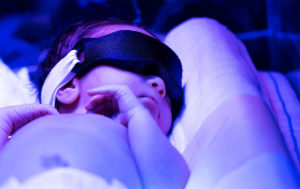Jaundice and Hyperbilirubinemia Can Lead to Kernicterus and the Development of CP
While many newborns suffer from mild jaundice, more-severe cases can be dangerous and could lead to a bilirubin-induced brain dysfunction called kernicterus. In newborn children, kernicterus can result in neurological damage and the development of cerebral palsy.
Jaundice is caused by an excess of bilirubin in the baby’s blood, and is recognizable by a yellowing of the skin. While everyone has a certain amount of bilirubin in their blood, babies with elevated bilirubin levels (or hyperbilirubinemia) at birth may not be able to effectively remove this compound via the liver alone.
When bilirubin levels increase to a dangerous level, it may enter the tissue of the brain (kernicterus) and cause permanent brain damage and cerebral palsy. Kernicterus is commonly associated with sick or premature newborns due to the fact that neither their liver nor kidneys are developed enough to allow them to quickly eliminate excess bilirubin from the blood.

Hyperbilirubinemia & Cerebral Palsy
Some of the signs of excessive bilirubin or hyperbilirubinemia are:
- Yellowish tint to the skin and whites of the eyes
- Overly lethargic
- Abnormal sleepiness
- Cry is high-pitched
- Decrease in muscle tone
- Arching backward of the head and back
A child who suffers from kernicterus may exhibit a variety of health issues, including hearing loss, deafness, and/or disorders involving movement. Children who developed kernicterus are frequently diagnosed with athetoid-dyskinetic cerebral palsy.
The Correlation Between Jaundice, Kernicterus, and Cerebral Palsy
When not treated adequately or quickly enough, severe cases of jaundice can cause a number of life-long disabilities, including cerebral palsy. Although bilirubin-related brain damage is rare in today’s world, the following risk factors must be addressed by medical personnel to quickly identify and treat babies at serious risk in order to avoid long-term complications:
- Preterm delivery
- Parents of East Asian or Mediterranean descent
- Rh incompatibility between mother and baby
- Another child in the family with jaundice at birth
- Baby was extremely large at birth
- Medical conditions which makes it difficult for the baby to process and remove bilirubin
- Bleeding under the scalp
- Presence of infections such as syphilis, sepsis, or rubella
Diagnosis and Treatment
Medical professionals use simple blood tests in order to diagnose the presence of excessive bilirubin. The condition is typically treated with phototherapy. This involves placing the baby under a special light in order to reduce the levels of bilirubin. Another similar treatment option is a fiber-optic therapy blanket. When the condition is serious, the physician may choose to order a blood transfusion in order to bring the bilirubin levels down to normal levels.
Because medical technology makes it so easy to diagnose and treat excessive bilirubin in newborn children, it’s rather devastating when any child develops kernicterus. If a doctor or nurse fails to test for, identify, and treat elevated levels of bilirubin, this could be considered medical malpractice.
Was it Medical Malpractice?
It’s important to understand that in almost every case, excessive bilirubin in a newborn is completely treatable. Obstetricians and other medical professionals are trained in the process of testing for bilirubin levels and treating jaundice immediately after birth. If they fail to test and treat the condition, and the child develops kernicterus or cerebral palsy, you may have a case for medical malpractice — but you really need to discuss the facts of your case with an attorney.
Not all birth injuries are caused by malpractice, but if you feel as though treatment fell below the accepted standard of practice in the medical community, it’s probably a good idea to discuss your options with a birth injury lawyer.
